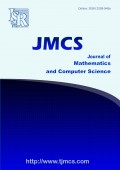Inventory Model for Time Dependent Holding Cost and Deterioration with Salvage Value and Shortages
-
3617
Downloads
-
5223
Views
Authors
Vinod Kumar Mishra
- Department of Computer Science and Engineering, B.T. Kumaon Institute of Technology, Dwarahat, Almora, - 263653, (Uttarakhand), INDIA
Abstract
In this paper, a deterministic inventory model is developed for deteriorating items in which shortages are allowed and salvage value is incorporated to the deteriorated items. In this model the demand rate is constant, deterioration rate is time dependent with weibull’s distribution and holding cost is a linear function of time. The model is solved analytically by minimizing the total inventory cost. Numerical analysis is provided to illustrate the solution and application of the model. The model can be applied to optimizing the total inventory cost for the business enterprises where holding cost and deterioration rate both are time dependent and salvage value is incorporated to the deteriorated items.
Share and Cite
ISRP Style
Vinod Kumar Mishra, Inventory Model for Time Dependent Holding Cost and Deterioration with Salvage Value and Shortages, Journal of Mathematics and Computer Science, 4 (2012), no. 1, 37--47
AMA Style
Mishra Vinod Kumar, Inventory Model for Time Dependent Holding Cost and Deterioration with Salvage Value and Shortages. J Math Comput SCI-JM. (2012); 4(1):37--47
Chicago/Turabian Style
Mishra, Vinod Kumar. "Inventory Model for Time Dependent Holding Cost and Deterioration with Salvage Value and Shortages." Journal of Mathematics and Computer Science, 4, no. 1 (2012): 37--47
Keywords
- Inventory
- deteriorating items
- shortages
- time dependent deterioration
- salvage value
- weibull’s distribution
- time varying holding cost.
MSC
References
-
[1]
P. L. Abad, Optimal price and order-size for a reseller under partial backlogging, Computers and Operation Research, 28 (2001), 53-- 65
-
[2]
P. L. Abad, Optimal pricing and lot-sizing under conditions of perishability and partial backordering, Management science, 42 (1996), 1093--1104
-
[3]
P. M. Ghare, A model for an exponentially decaying inventory, J. Ind. Engng., 14 (1963), 238--243
-
[4]
S. K. Goyal, B. C. Giri, Recent trends in modeling of deteriorating inventory, Eur. J. Oper. Res., 134 (2001), 1--16
-
[5]
F. W. Harris, Operations and cost, Aw Shaw Co., Chicago (1915)
-
[6]
K. Skouri, S. Papachristos, S. K. Goyal, An EOQ model with trade credit period depending on the ordering quantity, Journal of Information & Optimization Sciences, 29 (2008), 947--961
-
[7]
K.-C. Hung , An inventory model with generalized type demand, deterioration and backorder rates, Eur. J. Oper. Res., 208 (2011), 239--242
-
[8]
W. C. Lee, J. W. Wu, A note on EOQ model for items with mixtures of exponential distribution deterioration, shortages and time-varying demand, Quality and Quantity, 38 (2004), 457--473
-
[9]
J. J. Liao, An EOQ model with non instantaneous receipt and exponential deteriorating item under two–level trade credit, Int. J. Prod. Econ., 113 (2008), 852--861
-
[10]
V. K. Mishra, L. S. Singh, Deteriorating inventory model with time dependent demand and partial backlogging, Applied Mathematical Sciences, 4 (2010), 3611--3619
-
[11]
S. Pareek, V. K. Mishra, S. Rani, An Inventory Model for time dependent deteriorating item with salvage value and shortages, Mathematics Today, 25 (2009), 31--39
-
[12]
A. Roy, An inventory model for deteriorating items with price dependent demand and time varying holding cost, Advanced Modeling and Optimization, 10 (2008), 25--37
-
[13]
K. Skouri, I. Konstantaras, S. Papachristos, I. Ganas, Inventory models with ramp type demand rate, partial backlogging and Weibull deterioration rate, Eur. J. Oper. Res., 192 (2009), 79--92
-
[14]
V. K. Mishra, L. Sahab Singh, Deteriorating inventory model for time dependent demand and holding cost with partial backlogging, International Journal of Management Science and Engineering Management, 4 (2011), 267--271
-
[15]
Y. F. Huang, K. H. Hsu, A note on a buyer-vendor EOQ model with changeable lead-time in supply chain, Journal of Information & Optimization Sciences, 29 (2008), 305--310

